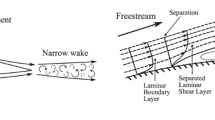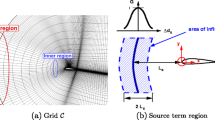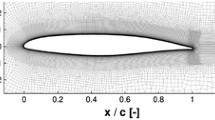Abstract
The laminar-to-turbulent transition process in a laminar separation bubble formed over a NACA 0018 airfoil is investigated experimentally. All experiments are performed for an angle of attack of 4\(^{\circ }\), chord Reynolds numbers of 80,000 and 125,000, and free-stream turbulence intensities between 0.06 and 1.99%. The results show that increasing the level of free-stream turbulence intensity leads to a decrease in separation bubble length, attributed to a downstream shift in mean separation and an upstream shift in mean reattachment, the later ascribed to an upstream shift in mean transition. Maximum spatial amplification rates of disturbances in the separated shear layer decrease with increasing free-stream turbulence intensity, implying that the larger initial amplitudes of disturbances are solely responsible for the upstream shift in mean transition and as a result mean reattachment. At the baseline level of turbulence intensity, coherent structures forming in the aft portion of the bubble are characterized by strong spanwise coherence at formation, and undergo spanwise deformations leading to localized breakup in the vicinity of mean reattachment. As the level of free-stream turbulence intensity is increased, the spanwise coherence of the shear layer rollers is reduced, and spanwise undulations in the vortex filaments start to take place at the mean location of roll-up. At the highest level of turbulence intensity investigated, streamwise streaks originating in the boundary layer upstream of the separation bubble are observed within the bubble. These streaks signify an onset of bypass transition upstream of the separation bubble, which gives rise to a highly three-dimensional shear layer roll-up. A quantitative analysis of the associated changes in salient characteristics of the coherent structures is presented, connecting the effect of elevated free-stream turbulence intensity on the time-averaged and dynamic characteristics of the separation bubble.




















Similar content being viewed by others
Abbreviations
- a :
-
POD temporal coefficient
- c :
-
Airfoil chord length
- d :
-
Characteristic turbulence generating grid element size
- \(E_{\mathrm{r}}\) :
-
Relative POD modal energy content
- f :
-
Frequency
- \(f_0\) :
-
Central frequency of unsteady disturbances
- H :
-
Shape factor, \(H=\delta ^{*}/\theta\)
- \(k_x\) :
-
Streamwise wavenumber
- l :
-
Spanwise coherence length
- \(\ell\) :
-
Mean separation bubble length
- M :
-
Characteristic turbulence generating grid mesh size
- n :
-
POD mode number
- \(P_a\) :
-
Power spectrum of a
- \(P_{uu}\) :
-
Power spectrum of u
- \(P_{vv}\) :
-
Power spectrum of v
- \(P_{2{\mathrm{D}}}\) :
-
Wavenumber–frequency spectrum of v
- \(St\) :
-
Chord-based Strouhal number, \(St =fc/U_0\)
- \(St _0\) :
-
Strouhal number based on central disturbance frequency, \(f_0\)
- \(\varDelta St\) :
-
Non-dimensional unstable frequency band width
- \(\text{Tu}\) :
-
Free-stream turbulence intensity
- U, V :
-
Streamwise and wall-normal velocity components
- u, v :
-
Fluctuating components of U and V
- \(u', v'\) :
-
Root-mean-square of u and v
- \(\overline{U}\) :
-
Time-average of U
- \(U_{\mathrm{c}}\) :
-
Convective velocity
- \(U_{\mathrm{e}}|_{\mathrm{S}}\) :
-
Boundary layer edge velocity at mean separation
- \(U_0\) :
-
Free-stream velocity
- \(U_X\) :
-
Chordwise velocity component
- x, y, z :
-
Wall-attached streamwise, vertical, and spanwise coordinates
- X :
-
Chordwise coordinate
- \(x_{\mathrm{S}},x_{\mathrm{T}},x_{\mathrm{R}}\) :
-
Locations of mean separation, transition, and reattachment
- \(\alpha\) :
-
Angle of attack
- \(\beta\) :
-
Turbulence generating grid porosity
- \(\delta ^*\) :
-
Displacement thickness
- \(\lambda _x, \lambda _z\) :
-
Streamwise and spanwise wavelengths
- \(\varLambda\) :
-
Integral length scale
- \(\psi _{u_X}^{(n)}, \psi _v^{(n)}\) :
-
X and v components of the POD eigenfunction
- \(\sigma _{v',\max }\) :
-
Maximum spatial amplification rate of \(v'\)
- \(\theta\) :
-
Momentum thickness
- \(\omega\) :
-
Spanwise vorticity
References
Balzer W, Fasel HF (2016) Numerical investigation of the role of free-stream turbulence in boundary-layer separation. J Fluid Mech 801(August):289–321
Boutilier MS, Yarusevych S (2012a) Parametric study of separation and transition characteristics over an airfoil at low Reynolds numbers. Exp Fluids 52(6):1491–1506
Boutilier MS, Yarusevych S (2012b) Separated shear layer transition over an airfoil at a low Reynolds number. Phys Fluids 24(8):084105
Burgmann S, Schröder W (2008) Investigation of the vortex induced unsteadiness of a separation bubble via time-resolved and scanning PIV measurements. Exp Fluids 45(4):675–691
Burgmann S, Brücker C, Schröder W (2006) Scanning PIV measurements of a laminar separation bubble. Exp Fluids 41(2):319–326
Carmichael BH (1981) Low Reynolds number airfoil survey, vol 1. Technical report, NASA
Diwan SS, Ramesh ON (2009) On the origin of the inflectional instability of a laminar separation bubble. J Fluid Mech 629(June):263–298
Dovgal AV, Kozlov VV, Michalke A (1994) Laminar boundary layer separation: instability and associated phenomena. Prog Aerosp Sci 30(1):61–94
Durbin P, Wu X (2007) Transition beneath vortical disturbances. Annu Rev Fluid Mech 39:107–128
Gaster M (1967) The structure and behaviour of laminar separation bubbles. Technical report, Aeronautical Research Council
Hain R, Kähler C, Radespiel R (2009) Dynamics of laminar separation bubbles at low-Reynolds-number aerofoils. J Fluid Mech 630(July):129–153
Howe MS (1998) Acoustics of fluid–structure interactions. Cambridge University Press, Cambridge
Hunt J, Durbin P (1999) Perturbed vortical layers and shear sheltering. Fluid Dyn Res 24(6):375–404
Jacobs RG, Durbin P (2001) Simulations of bypass transition. J Fluid Mech 428(February):185–212
Jeong J, Hussain F (1995) On the identification of a vortex. J Fluid Mech 285(February):69–94
Jones LE, Sandberg RD, Sandham ND (2008) Direct numerical simulations of forced and unforced separation bubbles on an airfoil at incidence. J Fluid Mech 602(May):175–207
Jones LE, Sandberg RD, Sandham ND (2010) Stability and receptivity characteristics of a laminar separation bubble on an aerofoil. J Fluid Mech 648(April):257–296
Kurelek JW, Lambert AR, Yarusevych S (2016) Coherent structures in the transition process of a laminar separation bubble. AIAA J 54(8):2295–2309
Lambert AR, Yarusevych S (2017) Characterization of vortex dynamics in a laminar separation bubble. AIAA J 55(8):2664–2675
Lang M, Rist U, Wagner S (2004) Investigations on controlled transition development in a laminar separation bubble by means of LDA and PIV. Exp Fluids 36(1):43–52
Langari M, Yang Z (2013) Numerical study of the primary instability in a separated boundary layer transition under elevated free-stream turbulence. Phys Fluids 25(7):074106
Lardeau S, Leschziner M, Zaki TA (2012) Large Eddy Simulation of transitional separated flow over a flat plate and a compressor blade. Flow Turbul Combust 88(1):19–44
Lengani D, Simoni D (2015) Recognition of coherent structures in the boundary layer of a low-pressure-turbine blade for different free-stream turbulence intensity levels. Int J Heat Fluid Flow 54:1–13
Lengani D, Simoni D, Ubaldi M, Zunino P (2014) POD analysis of the unsteady behavior of a laminar separation bubble. Exp Therm Fluid Sci 58:70–79
Lissaman PBS (1983) Low-Reynolds-number airfoils. Annu Rev Fluid Mech 15(1):223–239
Marxen O, Henningson DS (2011) The effect of small-amplitude convective disturbances on the size and bursting of a laminar separation bubble. J Fluid Mech 671(March):1–33
Marxen O, Rist U (2010) Mean flow deformation in a laminar separation bubble: separation and stability characteristics. J Fluid Mech 660(October):37–54
Marxen O, Lang M, Rist U, Wagner S (2003) A combined experimental/numerical study of unsteady phenomena in a laminar separation bubble. Flow Turbul Combust 71(1):133–146
Marxen O, Lang M, Rist U (2013) Vortex formation and vortex breakup in a laminar separation bubble. J Fluid Mech 728(August):58–90
Matsubara M, Alfredsson PH (2001) Disturbance growth in boundary layers subjected to free-stream turbulence. J Fluid Mech 430(March):149–168
Maucher U, Rist U, Kloker M, Wagner S (2000) DNS of laminar-turbulent transition in separation bubbles. In: High performance computing in science and engineering ‘99’. Springer, Berlin, Heidelberg, pp 279–294
Mayle RE (1991) The role of laminar-turbulent transition in gas turbine engines. J Turbomach 113:509–537
McAuliffe BR, Yaras MI (2010) Transition mechanisms in separation bubbles under low- and elevated-freestream turbulence. J Turbomach 132(1):011004
Michelis T, Kotsonis M, Yarusevych S (2017) On the origin of spanwise vortex deformations in laminar separation bubbles. J Fluid Mech (under review)
Norberg C (2003) Fluctuating lift on a circular cylinder: review and new measurements. J Fluids Struct 17(1):57–96
Ol MV, McAuliffe BR, Hanff ES, Scholz U, Kähler C (2005) Comparison of laminar separation bubble measurements on a low Reynolds number airfoil in three facilities. In: 35th AIAA fluid dynamics conference and exhibit, Ontario, Toronto
Olson DA, Katz AW, Naguib AM, Koochesfahani MM, Rizzetta DP, Visbal MR (2013) On the challenges in experimental characterization of flow separation over airfoils at low Reynolds number. Exp Fluids 54(2):1470–1480
O’Meara MM, Mueller TJ (1987) Laminar separation bubble characteristics on an airfoil at low Reynolds numbers. AIAA J 25(8):1033–1041
Palumbo D (2012) Determining correlation and coherence lengths in turbulent boundary layer flight data. J Sound Vib 331(16):3721–3737
Pröbsting S, Yarusevych S (2015) Laminar separation bubble development on an airfoil emitting tonal noise. J Fluid Mech 780(October):167–191
Pröbsting S, Scarano F, Bernardini M, Pirozzoli S (2013) On the estimation of wall pressure coherence using time-resolved tomographic PIV. Exp Fluids 54(7):1567
Saric WS, Reed HL, Kerschen EJ (2002) Boundary-layer receptivity to freestream disturbances. Annu Rev Fluid Mech 34(1):291–319
Schlichting H, Gersten K (2000) Boundary-layer theory, 8th edn. Springer, Berlin
Sciacchitano A, Scarano F, Wieneke B (2013) PIV uncertainty quantification by image matching. Meas Sci Technol 24(4):045302
Simoni D, Lengani D, Ubaldi M, Zunino P, Dellacasagrande M (2017) Inspection of the dynamic properties of laminar separation bubbles: free-stream turbulence intensity effects for different Reynolds numbers. Exp Fluids 58(6):66
Sirovich L (1987) Turbulence and the dynamics of coherent structures. II. Symmetries and transformations. Q Appl Math 45(3):561–571
Spalart PR, Strelets MK (2000) Mechanisms of transition and heat transfer in a separation bubble. J Fluid Mech 403(January):329–349
Tani I (1964) Low-speed flows involving bubble separations. Prog Aerosp Sci 5:70–103
Taylor G (1937) The spectrum of turbulence. R Soc Lond Ser A Math Phys Sci 164(919):476–490
Watmuff JH (1999) Evolution of a wave packet into vortex loops in a laminar separation bubble. J Fluid Mech 397(October):119–169
Westin KJA, Boiko AV, Klingmann BGB, Kozlov VV, Alfredsson PH (1994) Experiments in a boundary layer subjected to free stream turbulence. Part 1. Boundary layer structure and receptivity. J Fluid Mech 281(December):193–218
Wilson PG, Pauley LL (1998) Two- and three-dimensional large-eddy simulations of a transitional separation bubble. Phys Fluids 10(11):2932–2940
Yarusevych S, Kotsonis M (2017a) Effect of local DBD plasma actuation on transition in a laminar separation bubble. Flow Turbul Combust 98(1):195–216
Yarusevych S, Kotsonis M (2017b) Steady and transient response of a laminar separation bubble to controlled disturbances. J Fluid Mech 813(February):955–990
Yarusevych S, Sullivan PE, Kawall JG (2009) On vortex shedding from an airfoil in low-Reynolds-number flows. J Fluid Mech 632(August):245–271
Zaki TA (2013) From streaks to spots and on to turbulence: exploring the dynamics of boundary layer transition. Flow Turbul Combust 91(3):451–473
Acknowledgements
The authors gratefully acknowledge the Natural Sciences and Engineering Research Council of Canada (NSERC Discovery 2017-04222) and Bombardier Aerospace (Scholarship) for funding this work.
Author information
Authors and Affiliations
Corresponding author
Rights and permissions
About this article
Cite this article
Istvan, M.S., Yarusevych, S. Effects of free-stream turbulence intensity on transition in a laminar separation bubble formed over an airfoil. Exp Fluids 59, 52 (2018). https://doi.org/10.1007/s00348-018-2511-6
Received:
Revised:
Accepted:
Published:
DOI: https://doi.org/10.1007/s00348-018-2511-6




